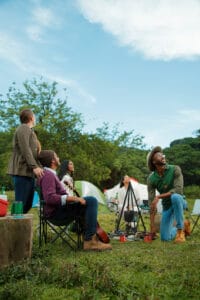Consumer buying trends are shifting. When it comes to outdoor equipment and gear, the days of visiting the local sporting goods store to catch weekend sales are dwindling. Customers are craving online convenience and education. The ability to shop from home (without a salesman lingering over our shoulder) via third-party re-sellers like Amazon and Walmart offer multiple pages of search results, reviews from everyday people and free front-door delivery.
Marketers are taking note of these buying behaviors and finessing their marketing tactics to match.
Outdoor Marketing Trends for 2019
As guests of the Outdoor Retailer tradeshow earlier this year, we visited dozens of booths to absorb innovative marketing trends and brand insights from successful companies. Rich with industry experts, panel discussions, brand ambassadors and product testing, we were taken back by the flow of knowledge sharing within the outdoor community and the digital transformation taking place in their marketing outreach.
Following our attendance at the show, and through our ongoing work in the outdoor space, we’ve keyed in on the following concepts shaping marketing initiatives in the outdoor industry.
Implement Audience Authenticity and Inclusivity
Consumers want to connect with brands that understand them, their interests and their experiences. When it comes to promoting that new sleeping pad or collapsible camp chair, inclusivity is key. If every image or video shows an accomplished mountaineer perched precariously on a portaledge, you’re missing a big part of your audience.
As you ideate your 2019 campaigns, consider representing various family structures, types of people and outdoor activities. Outside magazine says most products in this niche are flanked with thin, white males. Let’s challenge that status quo and introduce additional populations such as women of color, the active elderly and children with disabilities. After all, it’s a more accurate reflection of everyday consumers who enjoy outdoor products.
Leverage Brand Ambassadors and Influencers
Now take that level of connection and relatability one step further. Customers enjoy seeing genuine, candid reviews and feedback from trustworthy people like themselves and celebrities they follow online. The best way to incorporate this into your marketing plans is by including talented brand ambassadors and influencers.
For example, Instagram users with 10,000 to 100,000 followers have the highest engagement rates, according to Digiday, and could be considered for your next campaign. Whether you partner with a pro mountain biker sponsored by Niner, or an adventure photographer who only wears Salomon shoes, brands that connect with these influencers leverage their followers to help drive brand engagement and product interest. To be successful, brand managers must and set clear expectations for the ambassadors by sharing editorial guidelines, audience personas and branding strategy initiatives.
Create Brand-Owned Marketing Content
Although influencer relationships help move the needle, brands in the outdoor space must also invest in their own content ideation, creation, and publication. To maintain an authentic voice, the content should add value to the consumer’s research or buying process while nurturing a trusting relationship. The quality of the content must match the quality of the outdoor product or service by being impactful and consistently on-brand.
So, what type of content should you create? When it comes to digital marketing for the outdoor industry, The Digital Outdoorsman suggests focusing on content that’s honest, helpful and adds value. How to overcome relatable challenges, first-person stories and insights on technology trends all help build trust with your online audience.
When creating content for our outdoor product clients, we find success by telling insider brand stories related to production, usage and technology. Additionally, readers also respond well to topics about environmental sustainability as well as product testing and long-term performance reviews.
Invest in Search Marketing Tactics
After initiating authentic and inclusive content from both influencers and your brand’s content creation arm, you must ensure that the blog posts, videos, newsletters, and other content can be found online. The most successful outdoor brands rely on completely integrated search marketing tactics beyond siloed search-engine optimization (SEO) or search engine marketing (SEM) to rise above their competition.
We like to think of effective search marketing as a puzzle, where all the pieces fit together seamlessly to create a cohesive plan. SEO is critical to get your content to rank in the top of search engine results pages (SERPS) and drive organic traffic. SEM works to increase your content’s visibility in search engine rankings through options such as paid search and contextual advertising.
Revisit the Core Tools of Marketing
While the outdoor industry continues to grow, adapt and become even more creative in their messaging, brands that ignore foundational marketing concepts will not succeed. At Volume Nine we assist brands daily with improving their website tech performance, email outreach campaigns, social media strategy, and customer service.
It takes a documented plan, that ebbs and flows with consumer behaviors, to stand out in the competitive outdoor products market. We’ve seen this and learned to integrate consumer expectations and branding shifts to become leaders in this digital marketing vertical.
Although we’ve discussed emerging industry trends and effective marketing tactics, reaching consumers in the outdoor industry isn’t a one-size-fits-all endeavor. Each brand has a personal story that makes it truly unique and rise above the others. Your next campaign should embrace those attributes and use them to create a genuine, relatable voice.
If you would like to discuss your outdoor brand’s digital marketing plans for the year ahead, let’s set up a time to chat.




